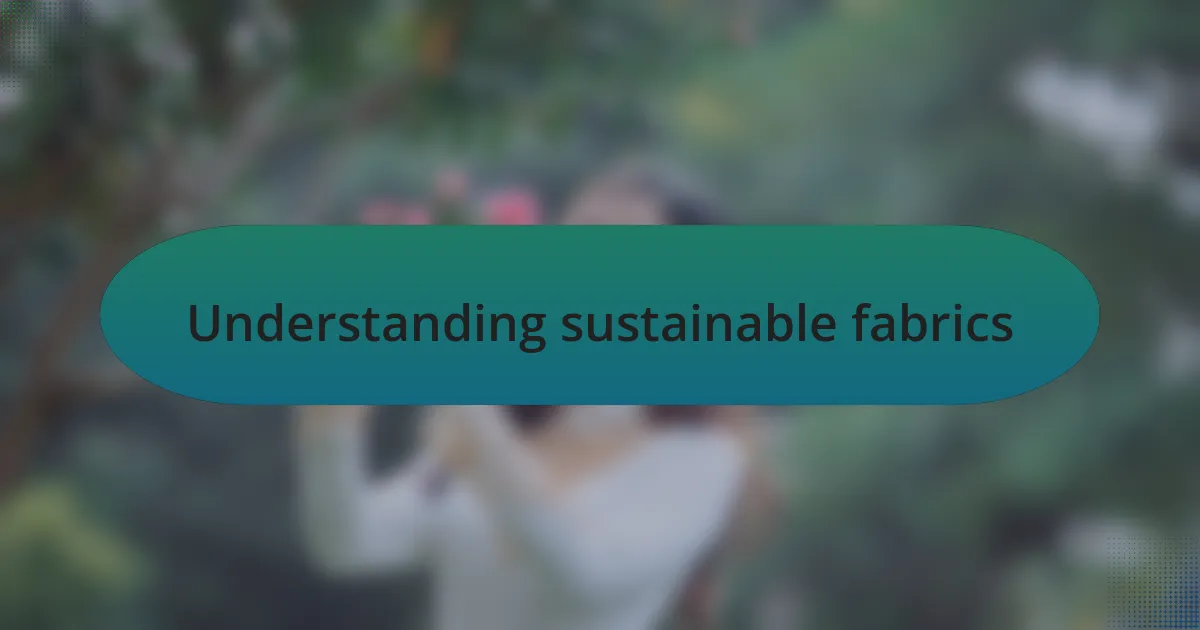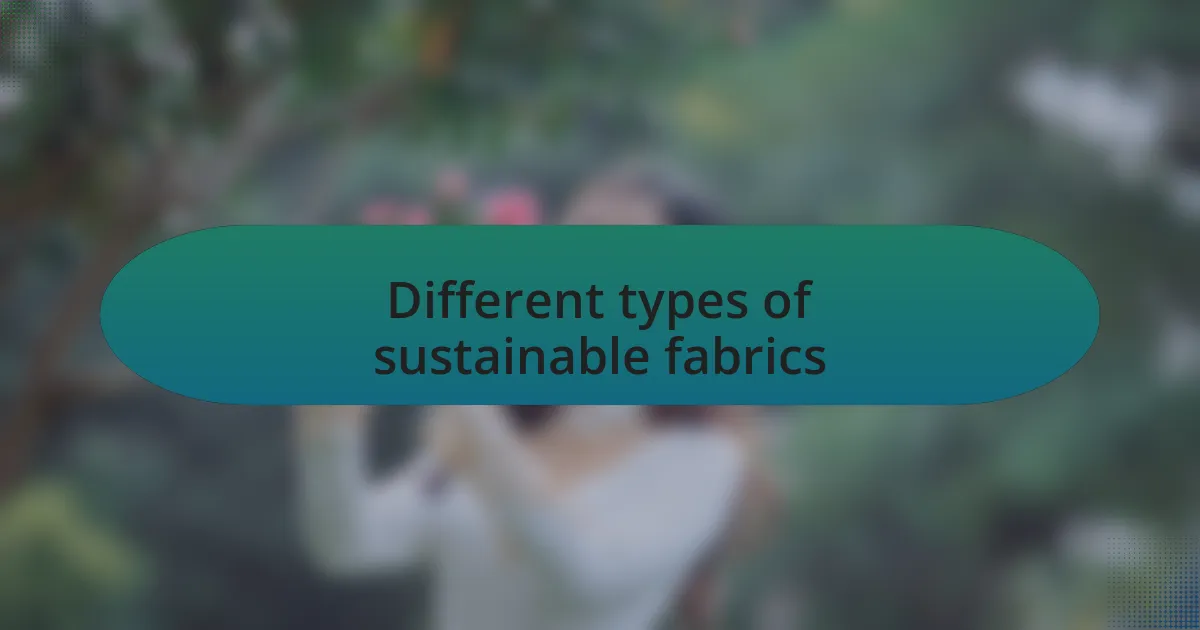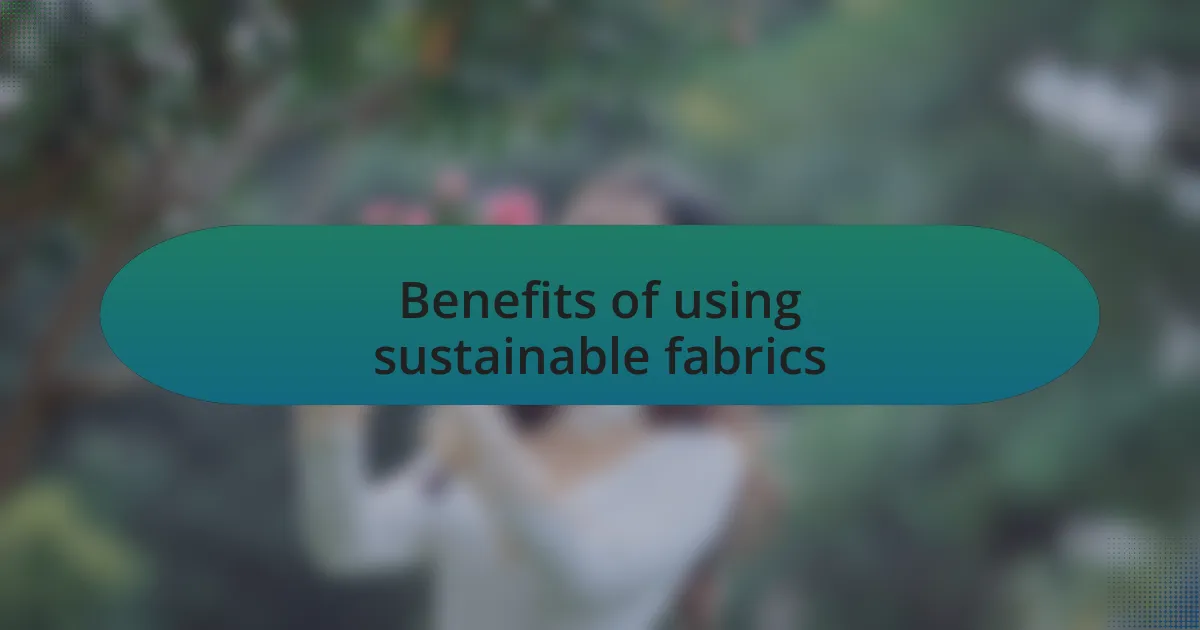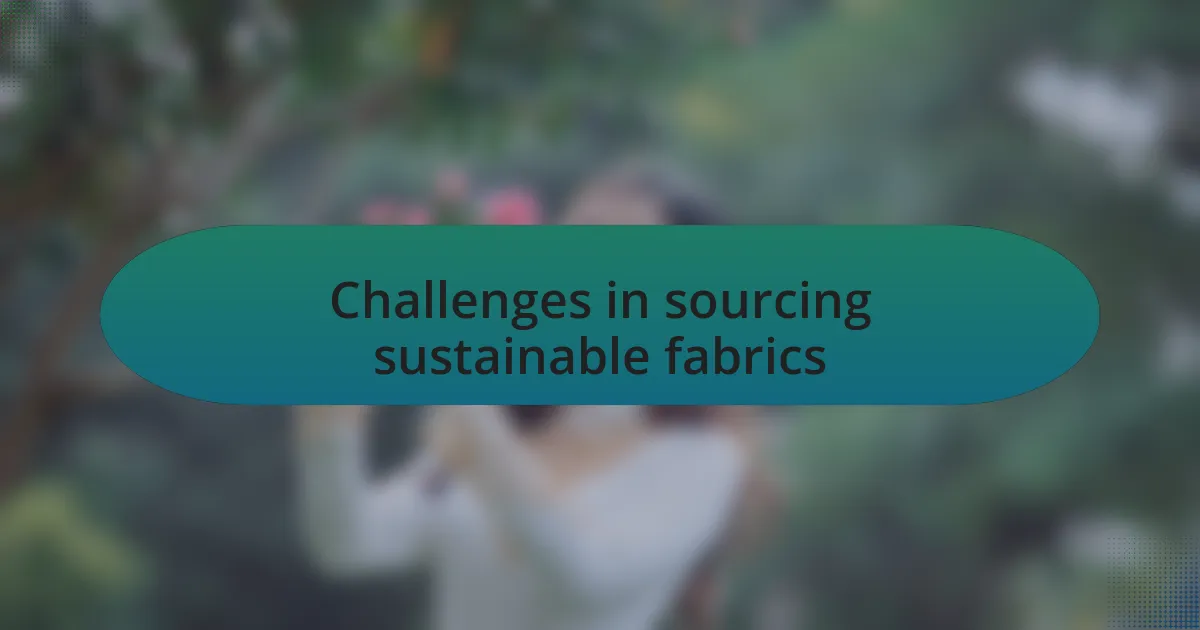Key takeaways:
- Sustainable fabrics like organic cotton, Tencel, and hemp significantly lower environmental impact and promote ethical practices in the fashion industry.
- The benefits of sustainable fabrics include positive environmental impacts, improved community health, and superior durability, leading to long-lasting garments.
- Challenges in sourcing include limited availability, unclear supply chain transparency, and inconsistent fabric quality, making informed decisions difficult.
- Incorporating sustainable fabrics can be approached gradually, through collaboration with experts, and educating consumers to foster a deeper connection to sustainable choices.

Understanding sustainable fabrics
When I first delved into sustainable fabrics, I was surprised to discover how deeply they connect to broader environmental issues. For instance, materials like organic cotton and hemp have a significantly lower environmental impact compared to conventional options. I immediately felt a sense of responsibility; choosing the right fabric isn’t just about aesthetics—it’s also about making ethical choices that support our planet.
Exploring the variety of sustainable fabrics can feel overwhelming. I remember standing in a fabric store, torn between the lush feel of organic linen and the durability of Tencel. It struck me then: sustainability isn’t just a buzzword; it’s a practical choice that feels good against your skin and aligns with a mindful lifestyle.
Consider how much water and energy traditional fabric production consumes—it’s staggering. By opting for sustainable alternatives, like the innovative use of recycled materials, I believe we can make a tangible difference. What if every garment we wore contributed to a healthier planet? That’s the vision many of us in the fashion world are striving for.

Different types of sustainable fabrics
When it comes to sustainable fabrics, one type that truly captivates me is organic cotton. I recall making my first organic cotton T-shirt and feeling an immediate emotional connection to the fabric. It wasn’t just soft against my skin; it represented a choice that supported farmers who practice sustainable agriculture. The thought that my clothing could promote healthier soil and contribute to biodiversity was thrilling.
Another fascinating option is Tencel, made from sustainably sourced wood pulp. I remember the first time I wore a Tencel dress; it felt so fluid and breathable. Learning that Tencel production uses a closed-loop process to minimize waste only made me appreciate it more. It raises an interesting question—can a fabric be both eco-friendly and luxurious? With Tencel, I believe the answer is a resounding yes.
Hemp is another standout for its versatility and durability. I had a hemp tote bag that lasted for years, far exceeding my expectations. The more I discovered about its low water usage and ability to grow without pesticides, the more I felt inspired to incorporate it into my designs. Isn’t it incredible how a simple plant can lead to such resilient, sustainable fabrics that transform our wardrobes?

Benefits of using sustainable fabrics
One of the most significant benefits of using sustainable fabrics is their positive impact on the environment. I distinctly remember visiting a textile facility that specialized in recycled materials, and witnessing the process of transforming discarded fabrics into new, high-quality textiles. It sparked a sense of hope in me, knowing that we could significantly reduce waste while still enjoying the beauty of fashion. Isn’t it empowering to wear something that actively contributes to less pollution?
Sustainable fabrics also enhance the health of our communities. For example, I once attended a local fashion show featuring garments made from organic linen, and the pride of the designers was palpable. They shared stories of how using non-toxic dyes not only beautified their creations but also ensured that vulnerable workers weren’t exposed to harmful chemicals. It made me reflect on the choices we make and their ripple effect on the lives of others. Why wouldn’t we want fabrics that safeguard both our skin and the environment?
Moreover, sustainable fabrics often boast superior quality and durability, which translates to longevity in our wardrobes. I have a jacket made from recycled polyester that I purchased years ago, and it still looks brand new. Every time I wear it, I’m reminded of the conservation story behind its creation. Isn’t it gratifying to invest in pieces that not only serve us well but also embody a commitment to sustainability? This dual benefit of durability and eco-friendliness is something I wholeheartedly advocate for in my design practices.

Challenges in sourcing sustainable fabrics
Sourcing sustainable fabrics may sound straightforward, but there are real challenges that often come into play. For instance, I recall trying to find organic cotton for a collection I was working on. The limited availability and higher costs were hurdles that made me reconsider my design choices. How do we balance the need for innovation with the constraints of sustainable sourcing?
Another significant challenge is the transparency of supply chains. I once connected with a fabric supplier who claimed to offer eco-friendly materials, but the details were murky. Without clear information on the sustainability practices behind the fibers, it’s difficult to make informed decisions. Have you ever felt overwhelmed by a lack of reliable data? I certainly have, and it often leaves me questioning my commitment to sustainability.
Lastly, the inconsistent quality of sustainable fabrics can be tricky. I vividly remember designing a dress using a supposedly sustainable fabric, only to find it didn’t hold its shape after a few washes. It felt like a betrayal of my values and raised the important question: can we really have both sustainability and quality? This experience underscored for me that sourcing sustainable materials is not just about their origin but also their performance in the long run.

Tips for incorporating sustainable fabrics
When incorporating sustainable fabrics into your designs, consider starting small. For example, I began by integrating sustainable elements into limited capsule collections. This approach allowed me to truly understand the fabrics and test their qualities without overcommitting. Have you ever found success in gradual changes? It’s a manageable way to explore sustainable materials without overwhelming your supply chain or your creativity.
Don’t underestimate the power of collaboration. I once teamed up with a local artisan who specialized in recycled textiles, and it was a game changer. Their insights into sourcing and working with reclaimed materials opened my eyes to possibilities I had never considered. Have you thought about reaching out to experts for help? Partnering with others can expand your creative horizons and strengthen your commitment to sustainability.
Finally, educate your customers about the fabrics you use. I remember hosting a small pop-up where I explained the benefits of organic linen versus conventional linen. The conversations we had sparked genuine interest and understanding among my customers, which deepened their connection to my brand. How often do you get a chance to share your passion for sustainable choices? Engaging your audience not only builds trust but also promotes a more sustainable mindset in the fashion community.